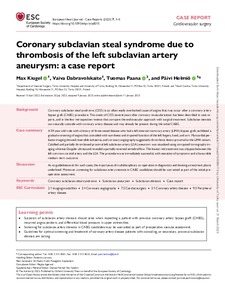Coronary subclavian steal syndrome due to thrombosis of the left subclavian artery aneurysm: a case report
Kiugel Max; Dabravolskaite Vaiva; Paana Tuomas; Helmiö Päivi
https://urn.fi/URN:NBN:fi-fe2023040134452
Tiivistelmä
Background: Coronary subclavian steal syndrome (CSSS) is an often easily overlooked cause of angina that may occur after a coronary artery bypass graft (CABG) procedure. The onset of CSSS several years after coronary revascularization has been described in case reports, and in the few retrospective reviews that compare the endovascular approach with surgical treatment. Subclavian stenosis can naturally coincide with coronary artery disease and may already be present during the initial CABG.
Case summary: A 59-year-old male with a history of three-vessel disease who had a left internal mammary artery (LIMA) bypass graft, exhibited a gradual worsening of angina that coincided with numbness and impaired function of the left fingers, hand, and arm. Myocardial perfusion imaging showed reversible ischaemia, and coronary angiography suggested a thrombotic lesion proximal to the LIMA ostium. Calcified and partially thrombosed proximal left subclavian artery (LSA) aneurysm was visualized using computed tomography imaging, whereas Doppler ultrasound revealed a partially reversed vertebral flow. The lowest risk treatment was a bypass between the left common carotid artery and the LSA. The procedure was immediately successful, with cessation of symptoms and a favourable medium-term outcome.
Discussion: As no guidelines exist for such cases, the importance of multidisciplinary co-operation in diagnostics and devising a treatment plan is underlined. Moreover, screening for subclavian artery stenosis in CABG candidates should be warranted as part of the initial preoperative assessment.
Kokoelmat
- Rinnakkaistallenteet [27094]
